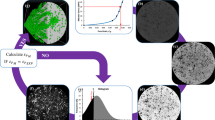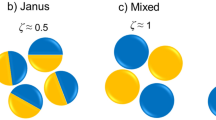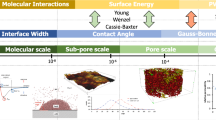Abstract
The multiphase distribution and transport properties in porous media are strongly influenced by capillary pressure and rock–fluid interactions. The influence of nano-scale wetting film caused by the disjoining pressure on the multiphase transport properties is not fully considered in the current pore scale modeling methods, and it is unclear how the nano-scale wetting film influences the transport behavior at different porous media scale. In this study, we propose a multiphase pore network transport model that considers capillary pressure, disjoining pressure (the latter arising only in fluid films on solid surfaces) and fluid transport mechanisms in irregular pores. The thickness of nano-scale wetting film under multiphase conditions in irregular pores is calculated based on the force balance between capillary pressure and disjoining pressure resulting from van der Waals force, electric double-layer interactions and structural force. The gas displacing water process is simulated in a water-wet 3D unstructured pore network extracted from 3D-reconstructed digitized shale image. The influence of nano-scale wetting film on essential transport properties including relative permeability, capillary pressure curve and resistivity index is analyzed, and its variation is elucidated for different porous media length scales. Notably, the nano-scale wetting film enhances the wetting-phase relative permeability and electrical conductivity in nano-scale porous media, and the effect is way less important on micron-scale. We further conclude the deviation from the case without nano-scale water film can be attributed to the interplay of corner water transport area and nano-scale water film transport area in invaded pore throats by analyzing the wetting-phase distribution based on the proposed three microscopic parameters. We also found that the nano-scale wetting film causes more wetting fluid retention after displacement in nano-porous media, which possibly explains the low flowback rate after hydraulic fracturing in shale and ultra-tight sandstones.
Article Highlights
-
A multiphase pore network transport model that considers both capillary pressure and disjoining pressure is proposed.
-
Nano-scale wetting film enhances the wetting phase relative permeability and electrical conductivity in nano-scale porous media.
-
Nano-scale wetting film causes more wetting fluid retention after displacement in nanoporous media.

















Similar content being viewed by others
References
Abu-Al-Saud, M.O., Riaz, A., Tchelepi, H.A.: Multiscale level-set method for accurate modeling of immiscible two-phase flow with deposited thin films on solid surfaces. J Comput. Phys. 333, 297–320 (2017)
Achtermann, H.J., Hong, J., Wagner, W., Pruss, A.: Refractive index and density isotherms for methane from 273 to 373 K and at pressures up to 34 MPa. J Chem. Eng. Data 37, 414–418 (1992)
Al-Shemmeri, T.: Engineering fluid mechanics. Bookboon. (2012)
Bashkatov, A.N., Genina, E.A.: Water refractive index in dependence on temperature and wavelength: a simple approximation, Saratov Fall Meeting 2002: Optical Technologies in Biophysics and Medicine IV. International Society for Optics and Photonics 393–395 (2003)
Berg, J.C.: An introduction to interfaces & colloids: the bridge to nanoscience. World Scientific (2010)
Beskok, A., Karniadakis, G.E.: Report: a model for flows in channels, pipes, and ducts at micro and nano scales. Microscale Thermophys. Eng. 3, 43–77 (1999)
Blunt, M.J.: Multiphase Flow in Permeable Media: A Pore-Scale Perspective. Cambridge University Press, Cambridge (2017)
Blunt, M.J., Bijeljic, B., Dong, H., Gharbi, O., Iglauer, S., Mostaghimi, P., Paluszny, A., Pentland, C.: Pore-scale imaging and modelling. Adv. Water Resour. 51, 197–216 (2013)
Bradley, D.J., Pitzer, K.S.: Thermodynamics of electrolytes. 12. Dielectric properties of water and Debye-Hueckel parameters to 350.degree C and 1 kbar. J. Phys. Chem. 83, 1599–1603 (1979)
Churaev, N., Derjaguin, B.: Inclusion of structural forces in the theory of stability of colloids and films. J Colloid Interface Sci. 103, 542–553 (1985)
Dong, H., Blunt, M.J.: Pore-network extraction from micro-computerized-tomography images. Phys. Rev. E 80, 036307 (2009)
Ershadnia, R., Wallace, C.D., Soltanian, M.R.: Co2 geological sequestration in heterogeneous binary media: effects of geological and operational conditions. Adv. Geo-Energy Res. 4, 392–405 (2020)
Fang, C., Sun, S., Qiao, R.: Structure, thermodynamics, and dynamics of thin brine films in oil–brine–rock systems. Langmuir 35, 10341–10353 (2019)
Fang, C., Yang, Y., Sun, S., Qiao, R.: Low salinity effect on the recovery of oil trapped by nanopores: a molecular dynamics study. Fuel 261, 116443 (2020)
Golparvar, A., Zhou, Y., Wu, K., Ma, J., Yu, Z.: A comprehensive review of pore scale modeling methodologies for multiphase flow in porous media. Adv. Geo-Energy Res. 2, 418–440 (2018)
Gregory, J.: Interaction of unequal double layers at constant charge. J Colloid Interface Sci. 51, 44–51 (1975)
Han, M., Youssef, S., Rosenberg, E., Fleury, M., Levitz, P.: Deviation from Archie’s law in partially saturated porous media: Wetting film versus disconnectedness of the conducting phase. Phys. Rev. E 79, 031127 (2009)
Heath, J.E., Bryan, C.R., Matteo, E.N., et al.: Adsorption and capillary condensation in porous media as a function of the chemical potential of water in carbon dioxide. Water Resour Res. 50, 2718–2731 (2014)
Hu, H., Sun, Y.: Multiscale modeling of thin liquid films. In: Weinberger, C.R., Tucker, G.J. (eds.) Multiscale Materials Modeling for Nanomechanics, pp. 507–536. Springer International Publishing, Cham (2016)
Israelachvili, J.N.: Intermolecular and Surface Forces. Academic press, Cambridge (2015)
Joekar-Niasar, V., Hassanizadeh, S.M., Dahle, H.: Non-equilibrium effects in capillarity and interfacial area in two-phase flow: dynamic pore-network modelling. J. Fluid Mech. 655, 38–71 (2010)
Karniadakis, G., Beskok, A., Aluru, N.: Microflows and Nanoflows: Fundamentals and Simulation. Springer Science & Business Media, Berlin (2006)
Kelly, S., Torres-Verdín, C., Balhoff, M.T.: Anomalous liquid imbibition at the nanoscale: the critical role of interfacial deformations. Nanoscale 8, 2751–2767 (2016)
Kim, T.W., Tokunaga, T.K., Shuman, D.B., Sutton, S.R., Newville, M., Lanzirotti, A.: Thickness measurements of nanoscale brine films on silica surfaces under geologic co2 sequestration conditions using synchrotron x-ray fluorescence. Water Resour. Res. (2012). https://doi.org/10.1029/2012WR012200
Kuchin, I.V., Matar, O.K., Craster, R.V., Starov, V.M.: Influence of the disjoining pressure on the equilibrium interfacial profile in transition zone between a thin film and a capillary meniscus. Colloids Interface Sci. Commun. 1, 18–22 (2012)
Landry, C.J., Prodanović, M., Eichhubl, P.: Direct simulation of supercritical gas flow in complex nanoporous media and prediction of apparent permeability. Int. J. Coal Geol. 159, 120–134 (2016)
Lee, A.L., Gonzalez, M.H., Eakin, B.E.: The viscosity of natural gases. J. Pet. Technol. 18, 997–1000 (1966)
Li, M., Tang, Y., Bernabé, Y., Zhao, J.Z., Li, X.F., Bai, X.Y., Zhang, L.H.: Pore connectivity, electrical conductivity, and partial water saturation: network simulations. J. Geophys. Res. Solid Earth 120, 4055–4068 (2015)
Liang, B., Zarikos, I.M., Bartels, W.B., Hassanizadeh, S.M., Clarens, A.: Effect of nanoscale surface textures on multiphase flow dynamics in capillaries. Langmuir 35, 7322–7331 (2019)
Mahady, K., Afkhami, S., Kondic, L.: A numerical approach for the direct computation of flows including fluid-solid interaction: Modeling contact angle, film rupture, and dewetting. Phys. Fluids. 28, 062002 (2016)
Mahmoud, M.: Development of a new correlation of gas compressibility factor (Z-factor) for high pressure gas reservoirs. J. Energy Res. Technol. DOI (2014). https://doi.org/10.1115/1.4025019
Mason, G., Morrow, N.R.: Capillary behavior of a perfectly wetting liquid in irregular triangular tubes. J Colloid Interface Sci. 141, 262–274 (1991)
Mehmani, A., Verma, R., Prodanović, M.: Pore-scale modeling of carbonates. Mar. Pet. Geol. 114, 104141 (2020)
Narayanan, S., Fedorov, A.G., Joshi, Y.K.: Interfacial transport of evaporating water confined in nanopores. Langmuir 27, 10666–10676 (2011)
Patzek, T., Silin, D.: Shape factor and hydraulic conductance in noncircular capillaries: I. One-phase creeping flow. J. Colloid Interface Sci. 236, 295–304 (2001)
Prodanović, M., Bryant, S.L.: A level set method for determining critical curvatures for drainage and imbibition. J. Colloid Interface Sci. 304, 442–458 (2006)
Raeini, A.Q., Bijeljic, B., Blunt, M.J.: Generalized network modeling of capillary-dominated two-phase flow. Phys Rev E 97, 023308 (2018)
Reynolds, C.A., Menke, H., Andrew, M., Blunt, M.J., Krevor, S.: Dynamic fluid connectivity during steady-state multiphase flow in a sandstone. Proc. Natl. Acad. Sci. 114, 8187–8192 (2017)
Rücker, M., Bartels, W.B., Garfi, G., Shams, M., Bultreys, T., Boone, M., Pieterse, S., Maitland, G.C., Krevor, S., Cnudde, V., Mahani, H.: Relationship between wetting and capillary pressure in a crude oil/brine/rock system: from nano-scale to core-scale. J Colloid Interface Sci. 562, 159–169 (2020)
Sedghi, M., Piri, M., Goual, L.: Molecular dynamics of wetting layer formation and forced water invasion in angular nanopores with mixed wettability. J. Chem. Phys. 141, 194703 (2014)
Sinha, S., Gjennestad, M.A., Vassvik, M., Hansen, A.: A dynamic network simulator for immiscible two-phase flow in porous media. arXiv preprint arXiv 1907, 12842 (2019)
Song, W., Yin, Y., Landry, C.J., Prodanovic, M., Qu, Z., Yao, J.: A local-effective-viscosity multi-relaxation-time lattice Boltzmann-pore network coupling model for gas transport in complex nanoporous media. SPE J. 26, 461–481 (2021)
Toumelin, E., Torres-Verdín, C.: Object-oriented approach for the pore-scale simulation of DC electrical conductivity of two-phase saturated porous media. Geophysics 73, E67–E79 (2008)
Tokunaga, T.K.: DLVO-based estimates of adsorbed water film thicknesses in geologic CO2 reservoirs. Langmuir 28, 8001–8009 (2012)
Tuller, M., Or, D., Dudley, L.M.: Adsorption and capillary condensation in porous media: liquid retention and interfacial configurations in angular pores. Water Resour. Res. 35, 1949–1964 (1999)
Tuller, M., Or, D.: Hydraulic conductivity of variably saturated porous media: film and corner flow in angular pore space. Water Resour. Res. 37, 1257–1276 (2001)
Uhlig, H.H., Keyes, F.G.: The dependence of the dielectric constants of gases on temperature and density. J Chem. Phys. 1, 155–159 (1933)
Valvatne, P.H., Blunt, M.J.: Predictive pore-scale modeling of two-phase flow in mixed wet media. Water Resour. Res. (2004). https://doi.org/10.1029/2003WR002627
Van Honschoten, J.W., Brunets, N., Tas, N.R.: Capillarity at the nanoscale. Chem. Soc. Rev. 39, 1096–1114 (2010)
Vega, C., De Miguel, E.: Surface tension of the most popular models of water by using the test-area simulation method. J. Chem. Phys. 126, 154707 (2007)
Wang, T., Tian, S., Li, G., Sheng, M., Ren, W., Liu, Q., Zhang, S.: Molecular simulation of CO2/CH4 competitive adsorption on shale kerogen for CO2 sequestration and enhanced gas recovery. J. Phys. Chem. 122, 17009–17018 (2018)
Wu, K., Nunan, N., Crawford, J.W., Young, I.M., Ritz, K.: An efficient Markov chain model for the simulation of heterogeneous soil structure. Soil Sci. Soc. Am. J. 68, 346–351 (2004)
Wu, K., Van Dijke, M.I., Couples, G.D., Jiang, Z., Ma, J., Sorbie, K.S., Crawford, J., Young, I., Zhang, X.: 3D stochastic modelling of heterogeneous porous media–applications to reservoir rocks. Transp. Porous Media 65, 443–467 (2006)
Wu, K., Chen, Z., Li, J., Li, X., Xu, J., Dong, X.: Wettability effect on nanoconfined water flow. PNAS 114, 3358–3363 (2017)
Wu, Q., Wong, H.: A slope-dependent disjoining pressure for non-zero contact angles. J. Fluid Mech. 506, 157–185 (2004)
Zhao, J., Qin, F., Derome, D., Carmeliet, J.: Simulation of quasi-static drainage displacement in porous media on pore-scale: coupling lattice boltzmann method and pore network model. J. Hydrol. 588, 125080 (2020a)
Zhao, J., Qin, F., Derome, D., Kang, Q., Carmeliet, J.: Improved pore network models to simulate single-phase flow in porous media by coupling with lattice Boltzmann method. Adv. Water Resour. 145, 103738 (2020b)
Acknowledgements
Jun Yao acknowledges the National Natural Science Foundation of China (No. 52034010), Wenhui Song acknowledges the Fundamental Research Funds for the Central Universities (No. 20CX06088A), Qingdao Postdoctoral Applied Research Project (qdyy20200083), Natural Science Foundation of Shandong Province (ZR2021QE022). Shandong Province Postdoctoral Innovation Program (202101010), Young Elite Scientist Sponsorship Program By Cast (No. YESS20200107).
Author information
Authors and Affiliations
Corresponding author
Ethics declarations
Conflict of interest
The authors report no conflict of interest.
Additional information
Publisher's Note
Springer Nature remains neutral with regard to jurisdictional claims in published maps and institutional affiliations.
Supplementary Information
Below is the link to the electronic supplementary material.
Rights and permissions
About this article
Cite this article
Song, W., Prodanović, M., Yao, J. et al. Nano-scale Wetting Film Impact on Multiphase Transport Properties in Porous Media. Transp Porous Med 149, 5–33 (2023). https://doi.org/10.1007/s11242-022-01800-9
Received:
Accepted:
Published:
Issue Date:
DOI: https://doi.org/10.1007/s11242-022-01800-9




